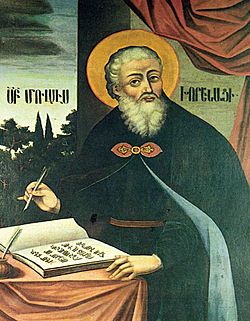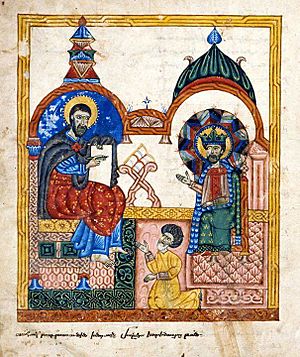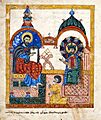Movses Khorenatsi facts for kids
Quick facts for kids SaintMovses Khorenatsi |
|
|---|---|

A painting of Movses Khorenatsi by Hovnatan Hovnatanian (1730–1801)
|
|
| Born | ca. 410 AD Kingdom of Armenia |
| Died | 490s AD Sassanid Armenia |
| Venerated in | Armenian Apostolic Church |
| Feast | Feast of the Holy Translators in October. |
| Patronage | Armenia |
Movses Khorenatsi (born around 410 AD, died in the 490s AD) was an important Armenian historian. He wrote a famous book called History of the Armenians. He is also known as Moses of Khoren.
His book was the first complete history of Armenia. It tells the story of Armenia from its very beginnings up to the 400s AD. Movses's work greatly influenced later Armenian writers. He is often called the "father of Armenian history" in his home country. Some even call him the "Armenian Herodotus", comparing him to the famous Greek historian. His book is also special because it shares unique stories from old Armenian oral traditions, which existed before Armenia became Christian.
Movses said he was a young student of Mesrop Mashtots. Mesrop Mashtots was the person who created the Armenian alphabet. Movses also claimed he wrote his history because Prince Sahak of the Bagratuni dynasty asked him to. The Armenian Apostolic Church recognizes Movses as one of the Holy Translators. Scholars have debated exactly when Movses lived and wrote. Some think he lived in the 600s or 800s AD, not the 400s.
Contents
Movses's Life Story
Early Life and School
We don't know much about Movses's life. He shared some details about himself in his History of the Armenians. Later Armenian writers added more information, but some scholars, like Stepan Malkhasyants, say these details might not be true.
Movses's name, Khorenatsi, suggests he was born in a place called Khoren. Some people thought he was born in Khorni, a village in the Taron area. However, Malkhasyants believes Movses was born in Khoreay, a village in the Syunik province.
If Movses lived in the 400s, he was likely born around 410 AD. He was probably about 22 or 23 when he traveled to Alexandria. Movses wrote that he was sent there after the Council of Ephesus in 431 AD. Malkhasyants thinks Movses first studied at a school in Syunik. This school was started by Mesrop Mashtots, the creator of the Armenian alphabet. After that, Movses went to Vagharshapat to study directly under Mashtots and Catholicos Sahak Partev.
After the Council of Ephesus, Mashtots and Sahak were working on the Armenian translation of the Bible. They decided to send Movses and other students to Alexandria, Egypt. Alexandria was one of the world's greatest learning centers at that time. They wanted the students to become experts in Greek learning and literature.
Journey and Return to Armenia
The students left Armenia between 432 and 435 AD. First, they went to Edessa to study in its libraries. Then, they traveled to Jerusalem and Alexandria. Movses and his classmates studied in Alexandria for seven years.
When they returned to Armenia, they found that Mesrop and Sahak had passed away. Things were also difficult in Armenia. The people were not welcoming to the students. Later Armenian historians blamed this on people being uneducated. However, the Persian rulers also played a part. They did not like highly educated young scholars who had just returned from Greek learning centers. Because of this difficult situation and persecution by the Persians, Movses hid in a village near Vagharshapat. He lived there quietly for many years.
One day, Gyut, who was the Catholicos of All Armenians (a high religious leader from 461–471 AD), met Movses while traveling. He didn't know who Movses truly was. Gyut invited Movses to dinner with some of his own students. Movses was quiet at first. But after Gyut's students encouraged him, Movses gave a wonderful speech. One of the Catholicos's students realized that Movses was someone Gyut had been looking for. It turned out that Gyut was one of Movses's old classmates and friends. Gyut brought Movses out of hiding and made him a bishop in Bagrevan.
History of the Armenians
While serving as a bishop, Movses was asked by Prince Sahak Bagratuni to write a history of Armenia. Prince Sahak had heard about Movses's good reputation. He specifically wanted to know about Armenian kings and the origins of Armenian noble families, called nakharar. One Armenian historian, Artashes Matevosyan, believes Movses finished his History in 474 AD.
Movses explained why he took on this important task in the first part of his book: "Even though we are small and have been conquered many times by foreign kingdoms, many brave acts have happened in our land. These acts deserve to be written down and remembered, but no one has bothered to write them." His book was the first historical record to cover all of Armenia's history, from ancient times until his own death. Movses's History was used as a textbook to study Armenian history until the 1700s.
Movses's history also describes many popular oral traditions of his time. These include the love story of Artashes and Satenik and the birth of the god Vahagn. Movses lived for several more years after finishing his book. He passed away sometime in the late 490s AD.
Later Views on Movses's Work
Movses's History has been studied and debated by scholars for a long time.
Early Studies
In the 1800s, scholars began to look at old historical sources more closely. Some started to question Movses Khorenatsi's History. Scholars like Alfred von Gutschmid began to doubt its accuracy. Many European and Armenian scholars in the late 1800s and early 1900s thought the History was less important as a source. They believed it was written much later, sometime between the 600s and 800s AD. Stepan Malkhasiants, an Armenian expert in old Armenian literature, said this period was like a "competition" to see who could criticize Khorenatsi the most.
However, in the early 1900s, scholars like F. C. Conybeare, Manuk Abeghian, and Malkhasiants disagreed with these ideas. They argued that Khorenatsi did indeed live in the 400s. Their findings were supported by new discoveries in archaeology and studies of different cultures. These discoveries confirmed some of the things Khorenatsi had written.
Modern Debates
In the second half of the 1900s, some scholars in Western countries brought back the arguments that questioned Movses's dating. Robert W. Thomson, a scholar of Armenian Studies at Harvard University, became a strong critic. In 1978, he published his English translation of History of the Armenians. Thomson called Khorenatsi a "bold, and dishonest, faker." He claimed that Khorenatsi's book contained mistakes about time periods and made-up stories.
However, many scholars in and outside Armenia quickly criticized Thomson's arguments. Gagik Sargsyan, an Armenian scholar, disagreed with Thomson. He said Thomson was being too critical and repeating old, exaggerated claims. Sargsyan pointed out that ancient or medieval writers had different rules for mentioning their sources than modern scientists do. Thomson's claims that Khorenatsi copied others or changed sources were also challenged. Scholars said Thomson was judging a medieval writer by today's standards. They noted that many famous Greek and Roman historians also used similar practices. Aram Topchyan, another scholar, agreed. He found it strange that Thomson would blame Khorenatsi for not mentioning his sources, as this was common practice among all classical historians.
Today, Movses Khorenatsi's work is seen as a very important source. It helps researchers study the history of Urartu and early Armenia. For example, Movses Khorenatsi's description of the ancient city of Van and its writings led to an expedition. This expedition, funded by the Société Asiatique of Paris, discovered the previously unknown Urartian language.
Other Works by Movses
The following writings are also believed to be by Movses:
- Letter on the Assumption of the Blessed Virgin Mary
- Homily on Christ's Transfiguration
- History of Rhipsime and Her Companions
- Hymns used in Armenian Church Worship
- Commentaries on the Armenian Grammarians
- Explanations of Armenian Church Offices
Images for kids
See also
 In Spanish: Moisés de Corene para niños
In Spanish: Moisés de Corene para niños




